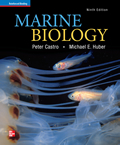
Marine Biology (Castro), 9th EditionChapter 6: Multicellular Primary Producers: Seaweeds and PlantsDo It Yourself SummaryRead each sentence and identify the word/phrase that you believe correctly completes the statement. Then, click on the arrow to see if your answer is correct.1. Seaweeds can be distinguished from plants because they lack three types of specialized tissues: , , and . 2. Two common kinds of photosynthetic pigments in seaweeds are and . 3. Unlike leaves, the blades of seaweeds do not have . 4. Three groups of seaweeds are recognized. In the green algae, is not masked by any other pigments, so the thallus is bright green. The algae include the largest and structurally most complex seaweeds, whereas the third group, the algae, includes the largest number of species. 5. Almost all flowering plants live on land except three groups. The are truly marine because they are rarely exposed to air. Two other groups, the salt marsh plants and , are essentially land plants that are salt-tolerant. 6. In the angiosperms, the dominant features an elaborate reproductive organ, the . 7. Of the three types of common seaweeds, only the often live in fresh water. 8. Gas-filled structures called help keep blades of kelp close to the surface. |  |















